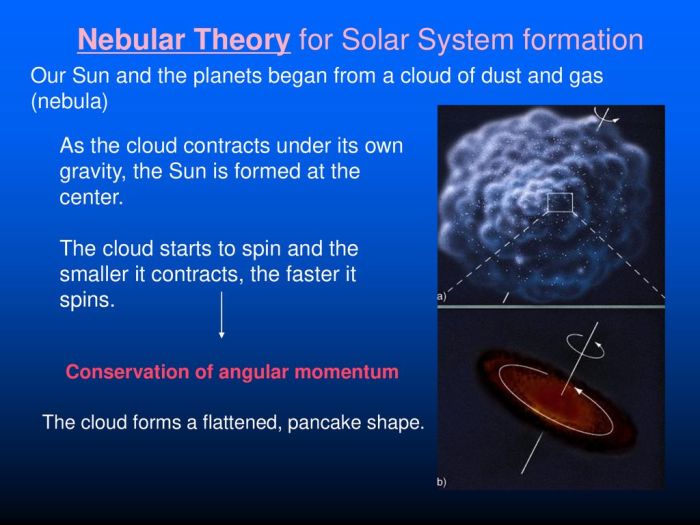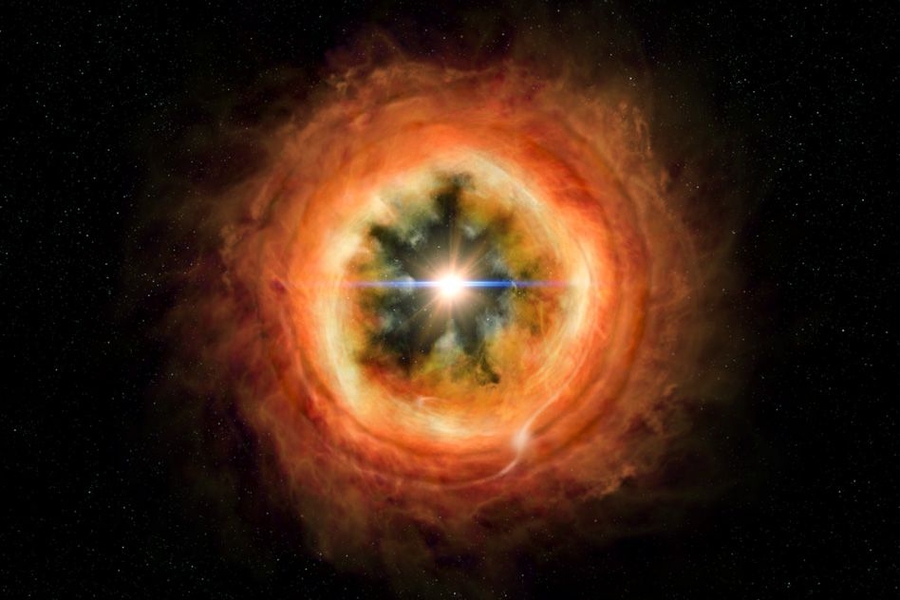As the solar nebula contracts it, a celestial tapestry unfolds, revealing the intricate processes that shaped our solar system. From the primordial cloud of gas and dust to the birth of planets and stars, this narrative explores the captivating journey of cosmic evolution.
The solar nebula, a swirling vortex of matter, holds the secrets to the formation of our celestial neighborhood. As it contracts under the relentless pull of gravity, it sets in motion a cascade of events that will ultimately give rise to the planets, moons, and the sun that illuminate our sky.
Formation of the Solar System
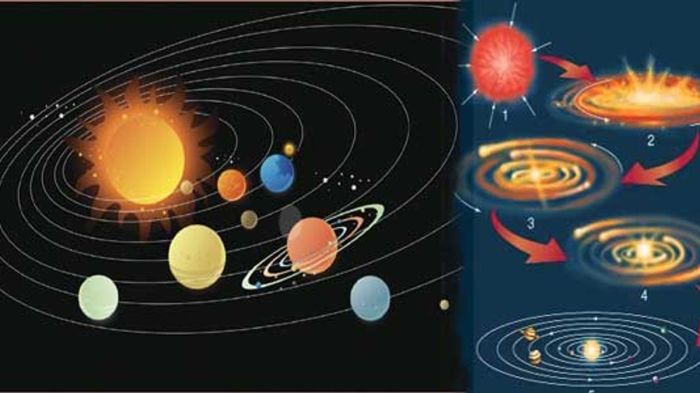
The formation of the solar system began with the gravitational collapse of a giant molecular cloud approximately 4.6 billion years ago. This cloud, composed primarily of hydrogen and helium, contained dust and gas that would eventually coalesce into the sun, planets, and other celestial bodies.
Solar Nebula Contraction
As the molecular cloud collapsed under its own gravity, it began to spin faster and flatten into a disk-like structure known as the solar nebula. The center of the nebula became increasingly dense and hot, forming a protostar that would eventually become the sun.
Meanwhile, the outer regions of the nebula remained cooler and less dense.
The contraction of the solar nebula was driven by several factors, including:
- Gravitational forces:The mutual gravitational attraction between the particles within the nebula caused them to clump together and collapse.
- Centrifugal forces:As the nebula rotated, centrifugal forces pushed the particles outward, counteracting the gravitational forces.
- Magnetic forces:Magnetic fields within the nebula interacted with the charged particles, influencing their movement and distribution.
Protoplanetary Disk
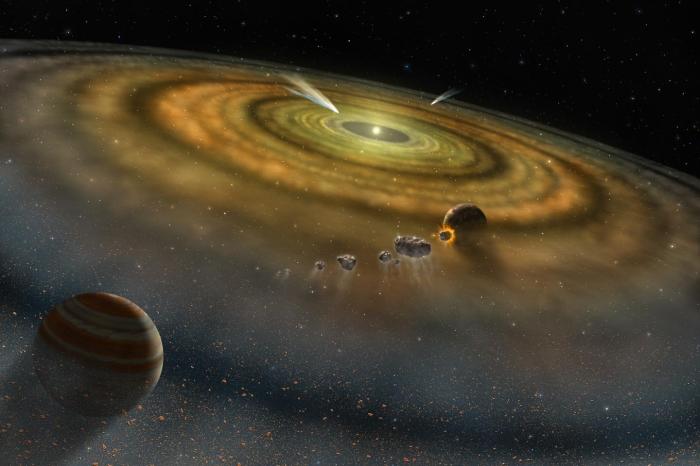
As the solar nebula contracted under its gravity, it flattened into a rotating disk. This disk, known as the protoplanetary disk, was the birthplace of the planets in our solar system.
Structure and Properties of the Protoplanetary Disk
The protoplanetary disk was a vast, swirling disk of gas and dust. It extended from the Sun to a distance of about 100 AU. The disk was hottest near the Sun and coolest at its outer edge. The temperature gradient caused the disk to be divided into different zones.
The inner zone, closest to the Sun, was hot enough to vaporize most materials, including metals and silicates. The outer zone, on the other hand, was cool enough for these materials to condense into solid particles.
Role of the Protoplanetary Disk in the Formation of Planets
The protoplanetary disk was the source of the material that formed the planets. Dust particles in the disk collided and stuck together, forming larger and larger bodies. These bodies, known as planetesimals, were the building blocks of the planets. Over time, the planetesimals grew in size through collisions and mergers.
Eventually, they reached a size where they could attract their own gas and dust, forming the planets we see today.
Planet Formation
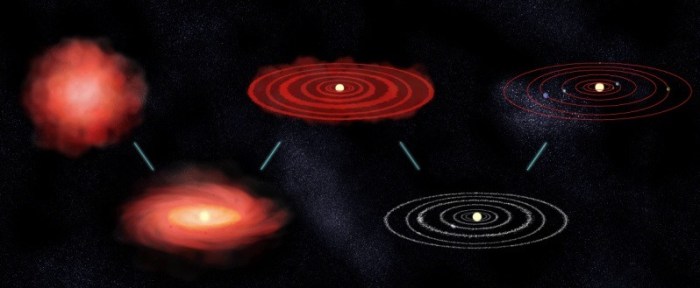
As the protoplanetary disk cooled and contracted, dust particles began to stick together, forming larger and larger bodies called planetesimals. These planetesimals then collided and merged, gradually growing into planets. The process of planet formation is complex and involves several different mechanisms.
Gravitational Accretion, As the solar nebula contracts it
The primary mechanism for planet formation is gravitational accretion. As dust particles collide, they stick together and form larger bodies. The gravitational pull of these larger bodies then attracts more dust particles, causing them to grow even larger. This process continues until the bodies become so large that their gravity is strong enough to hold them together as planets.
Planetesimal Collisions
Planetesimals often collide with each other, and these collisions can either merge the planetesimals together or break them apart. If two planetesimals collide head-on, they may merge together to form a larger planetesimal. If they collide at an angle, they may break apart into smaller pieces.
The outcome of a collision depends on the size, mass, and velocity of the planetesimals involved.
Orbital Resonances
Orbital resonances occur when two or more planets have orbital periods that are related to each other by a simple ratio. For example, the orbital periods of Jupiter and Saturn are in a 3:2 resonance, meaning that Jupiter orbits the Sun twice for every three orbits that Saturn makes.
Orbital resonances can stabilize the orbits of planets and prevent them from colliding with each other.
Different Types of Planets
The planets in the solar system can be divided into two main types: terrestrial planets and gas giants. Terrestrial planets are made up of rock and metal, and they have solid surfaces. Gas giants are made up of gas and ice, and they have no solid surfaces.
The terrestrial planets in the solar system are Mercury, Venus, Earth, and Mars. The gas giants are Jupiter, Saturn, Uranus, and Neptune.
Factors Influencing Planet Formation
The formation of planets is influenced by a number of factors, including the mass of the protoplanetary disk, the temperature of the disk, and the presence of other planets. The mass of the disk determines the amount of material that is available to form planets.
The temperature of the disk determines the type of planets that can form. In cooler regions of the disk, terrestrial planets can form. In warmer regions of the disk, gas giants can form. The presence of other planets can also influence the formation of planets.
If two planets are too close together, they may collide and destroy each other.
Solar Nebula Collapse: As The Solar Nebula Contracts It

The solar nebula collapse refers to the gravitational contraction of the vast cloud of gas and dust that gave birth to our solar system. This collapse played a pivotal role in shaping the characteristics of the sun and the formation of the planets within our system.The
solar nebula, initially a diffuse and sprawling cloud, underwent a gradual collapse due to its own gravitational force. As the cloud contracted, its density and temperature increased, leading to the formation of a central protostarthe precursor to our sun. The infalling matter from the nebula provided the necessary mass for the protostar to grow and eventually ignite nuclear fusion, marking the birth of the sun.
Mechanisms of Solar Nebula Collapse
Several mechanisms contributed to the collapse of the solar nebula:
-
-*Gravitational Instability
The gravitational force between the particles within the nebula exceeded the outward pressure, causing the cloud to contract.
-*Angular Momentum Conservation
As the nebula collapsed, it conserved its angular momentum. This resulted in the formation of a rotating disk-like structure around the protostar.
-*Magnetic Fields
Magnetic fields within the nebula acted as additional forces, guiding and shaping the collapsing cloud.
Impact on the Sun’s Characteristics
The collapse of the solar nebula had a profound impact on the characteristics of the sun:
-
-*Mass
The mass of the sun was determined by the amount of matter that collapsed inward.
-*Rotation
The conservation of angular momentum during the collapse resulted in the sun’s rapid rotation.
-*Temperature
The gravitational contraction increased the temperature and pressure within the nebula, leading to the ignition of nuclear fusion and the formation of the sun’s core.
-*Magnetic Field
The magnetic fields present in the nebula were amplified during the collapse, creating the sun’s strong magnetic field.
FAQ Overview
What is the solar nebula?
The solar nebula was a vast cloud of gas and dust that existed before the formation of the solar system.
How did the solar nebula contract?
The solar nebula contracted under the force of gravity.
What caused the formation of the protoplanetary disk?
The protoplanetary disk formed as the solar nebula contracted and began to spin.
How did the planets form?
The planets formed as dust and gas in the protoplanetary disk clumped together and grew.
